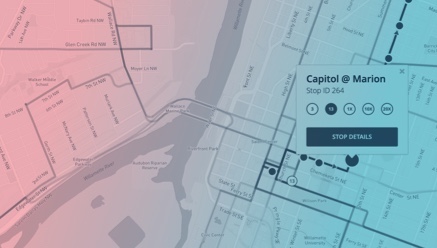Overview
Salem Area Mass Transit District engaged OMBU to design and launch a new website for Cherriots, a public agency providing bus service to the Salem, Oregon region. Their website needed to better support the region’s multilingual residents and visitors with up-to-date information about the transit services available to them, and help them plan trips.
The Visionary
Cherriots provides bus service to a 76-square-mile-plus area in Salem, Keizer, and the mid-Willamette Valley, operating local, regional, and paratransit bus services.

Cherriots needed a website capable of supporting on-the-go users on mobile, users on older devices and browsers, non-English speakers, and users with visual and/or hearing impairments. To maximize their staff resources, Cherriots needed the new site to cut down on their historically significant content management time and help visitors self-serve, reducing customer service inquiries.
Cherriots is a technology-forward agency and had made significant investments on transit planning technologies prior to engaging OMBU. So from the outset, Cherriots had the vision to leverage these investments and consolidate their data into feeds that would drive much of the transit data and mapping for the new site.

OMBU Contributions
- Technology Strategy
- User Experience Design
- Visual Design
- GTFS Feed Integration
- Custom Mapping with Mapbox
- AWS Infrastructure
- SMS and email Alerts for Service Disruptions
The Solution

OMBU designed and built a site where the majority of dynamic content is driven by Cherriots’ General Transit Feed Specification (GTFS) content. Stop pages, route pages, schedules, fares, and a robust system map are all populated and updated from the GTFS data. The GTFS data is also useful to maintain third-party services, such as Google Transit.
The design of the new site is focused around user tasks. Riders can reach route detail and stop pages in one or two clicks. Service alerts, which contain information about schedule changes and service interruptions, are accessible in context where relevant – on the homepage, on route pages, on stop pages, as well as in a single digest list. There is also a system map that users to explore bus routes and individual stops in the entire Cherriots system.

After launching the new Cherriots website, SAMTD (Salem Area Mass Transit District of Oregon) and OMBU continued to collaborate on site enhancements. Together, we added keyword search to the system map, enabling users to find routes and stops near a chosen address, landmark, or business, and to plan trips to/from this location with one click. Later, Cherriots introduced a new weekend bus service, and we revamped route and stop pages to allow visitors to toggle between the different services as they plan trips.
Accessibility was a critical goal for this website, so OMBU designed and built the website in alignment with WCAG (Web Content Accessibility Guidelines) 2.0 AA guidelines. To validate conformance, Cherriots contracted an external firm to perform independent accessibility testing.
Technology Highlights
![]()
Page builder
Rather than being locked into static templates, content editors may create pages arranging rich content blocks in layouts that best suit the needs of each page. The available blocks include rich text,media, callouts, route lists, fare tables, and are battle-tested to be accessible and responsive.
Next Highlight![]()
Transit data driven by GTFS
Cherriots maintains a General Transit Feed Specification (GTFS) data feed which contains rich information covering routes, stops, times, fares, service outages, and system status. The website consumes the feed and updates itself with any changes, so the most current information is available on every page of the site.
Next Highlight![A Cherriots rider interacting with the system map on a smartphone while outside.]()
System map
Also leveraging the GTFS feed, the website presents an up-to-date system map where users can explore the transit network, bus lines, and stops. The accuracy of this map enables users to plan trips with efficiency and confidence.
Next Highlight![]()
Service alerts
When Cherriots reports a service alert, it is automatically propagated to all applicable contexts on the website, such as the affected routes, stops, and — when there is a major outage — even the homepage. Users can subscribe to all alerts, or just those that affect the routes or stops they use, and receive SMS or email notifications with updates.
Next Highlight![]()
Localization
Cherriots provides services to a diverse population, and their website now supports native translation for all content. OMBU’s localization features give Cherriots the flexibility to translate the whole site, or just specific pages or sections as needed.






